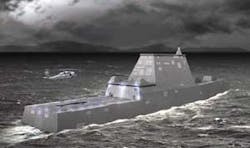By Ben Ames
WASHINGTON - Navy leaders have already taken two steps in 2006 toward creating an all-electric destroyer. They awarded a contract to build a propulsion motor for the DD(X), and they funded further research into creation of a rail gun that can launch projectiles with electrical charge instead of explosives.
In January, officials at the U.S. Navy’s Office of Naval Research (ONR) awarded a $10 million contract to American Superconductor Corp. (AMSC) in Westborough, Mass.
The award is an increase to AMSC’s contract to design and build a 36.5-megawatt high-temperature-superconductor (HTS) propulsion motor for electric warships.
AMSC and Northrop Grumman have already completed two of three phases to develop the 36.5-megawatt motor, including preliminary design and detailed design reviews. AMSC expects to deliver the completed motor to the Navy test facility in Philadelphia in September 2006.
As prime contractor, AMSC leads design, manufacture and initial testing. The prototype, which is sized for the Navy’s future DD(X) ships, benefits from the successes achieved by AMSC in a recently completed Navy project to build a smaller, 5-megawatt version.
Members of the AMSC team include:
- Northrop Grumman Marine Systems, which is responsible for the development of system requirements and specifications, design and manufacture of the motor drive, and certain mechanical components and system integration and test;
- Northrop Grumman Ship Systems, to assist in overall ship system integration and provide ancillary hardware;
- Electric Machinery Co. in Minneapolis;
- BMT Syntek Technologies Inc. in Arlington, Va.; and
- The Center for Advanced Power Systems at Florida State University.
HTS motors are ultracompact, measuring as little as one-third the weight and one-half the size of copper-based motors of the same power and torque rating, which means Navy ships could carry more fuel and munitions and could have more room for crew’s quarters and weapons systems; commercial ship owners and operators could carry more passengers and cargo.
In addition, HTS motors operate with higher fuel efficiency and are expected to have lower maintenance costs than their conventional copper counterparts. Finally, the cost of an HTS ship propulsion motor is expected to be equivalent to conventional motors of the same power and torque rating. For more information, see www.amsuper.com.
Navy leaders have awarded contracts to build an electric-propulsion motor and rail gun for the DD(X) destroyer.
In another January contract award, Navy leaders chose TPL Inc. in Albuquerque, N.M., for a $1.5 million contract to provide power supply components for a prototype rail gun-a device that uses a massive electrical charge to launch a projectile.
In a 10-year cooperative project with Sandia National Laboratories, also in Albuquerque, TPL has developed small, high-energy capacitors which act as batteries to store a huge electrical charge.
The concept is similar to the flash on a camera, but in practice, thousands of TPL’s fist-size capacitors would be located under a ship’s gun. On command, they would instantly release millions of joules of electricity-an amount of energy comparable to a bolt of lightning.
The electromagnetic rail gun uses a magnetic field powered by this electricity to accelerate a projectile to as fast as 52,493 feet per second. While current Navy guns have a maximum range of 12 miles, rail guns could hit a target 250 miles away in six minutes.
The rail guns would be used as an alternative to current large artillery like those mounted on a Navy battleship, and have the advantage of not relying on traditional explosives.
Rail-gun ammunition, in the form of small tungsten missiles similar to tank sabot rounds, would be relatively light, easy to transport, and easy to handle. Because of their high velocities, rail-gun missiles would be less susceptible to bullet drop and wind shift than current artillery shells. For more information, see www.tplinc.com.

